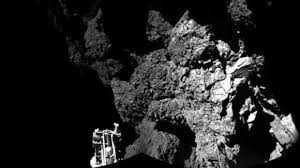It has been almost three months since the robotic probe Philae made history by being the first spacecraft to land on a comet. The problem is no one knows exactly where on this spinning hunk of ice and rock Philae is.
Scientists from the European Space Agency (ESA) have a general idea of the area in which Philae might be on the four kilometer wide comet. But they haven't positively identified Philae anywhere on the surface yet.
According to ESA, this is because the lander's small size means Philae shows-up as an image only three pixels across in photos taken from a distance of 20 kilometers by the orbiting Rosetta spacecraft's OSIRIS camera.
Rosetta will be commanded to fly to within six kilometers above Comet 67P/Churyumov-Gerasimenko on Valentine's Day. ESA scientists are hopeful this close approach will yield better high-resolution images that may finally pinpoint Philae's exact location.
Philae, which weighs 100 kilograms, bounced thrice off the comet's surface and landed where it shouldn't have. Its two grappling harpoons that should have attached it firmly to the surface failed to fire because of defective explosives.
Philae is now in hibernation as its batteries are almost completely drained. ESA scientists said Philae will reawaken in March when the comet approaches close to the Sun and sunlight can recharge its solar panels. Philae needs some 17 watts of power to recharge and again communicate with Rosetta.
"We're looking, by eye, for a set of three spots that correspond to the lander," said OSIRIS principal investigator Holger Sierks from the Max Planck Institute for Solar System Research (MPS) in Germany to Discovery News.
"The problem is that sets of three spots are very common all over the comet nucleus; Hatmehit and the area around its rim where we're looking is full of boulders and we have identified several sets of three spots," Sierks added.


